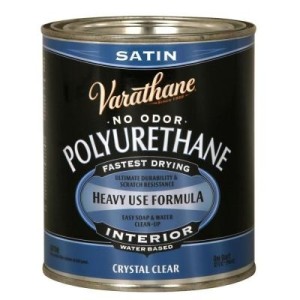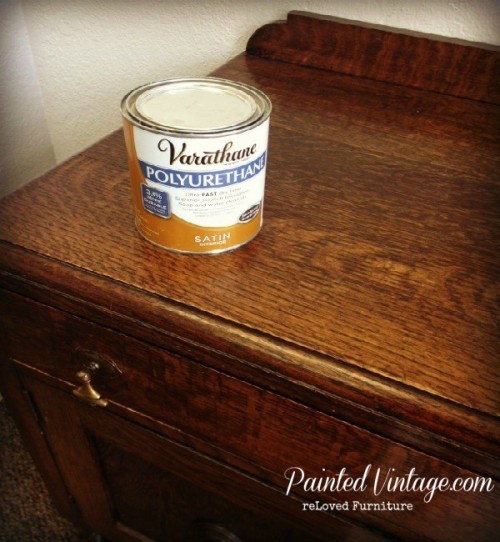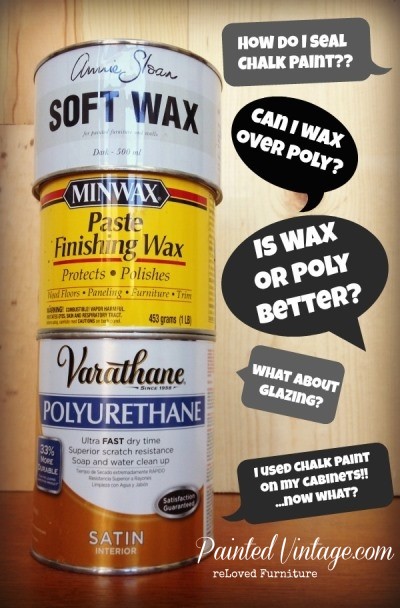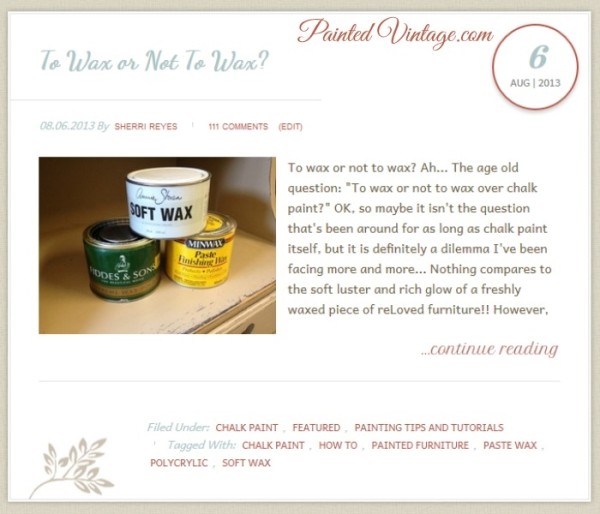Wax or Polycrylic over chalk paint?
All your questions about using wax vs. polycrylic over chalk paint answered!
The response has been overwhelming to my post on using wax or polycrylic over chalk paint (you can read the original post here: To Wax or Not to Wax?)
So, I decided to post an update with answers to your most frequently asked questions on applying a finish over chalk paint and wax alternatives.
Should I use a wax OR polycrylic over chalk paint? The answer really depends on how you will use the piece of furniture and how much time you are willing to invest in maintaining the finish. As I explained in my original post To Wax or Not to Wax? while waxing over chalk paint (or any variation of chalk style paint such as clay paint, mineral paint, and even DIY chalk paint) gives you a gorgeous velvety luster, it is NOT A PERMANENT finish and must be reapplied frequently to maintain the look and the protection of the wax. So if you absolutely must have the waxed finish, be prepared to also bust out a big can of elbow grease every few months!
That’s where water-based polyurethane finishes come in. Known as polycrylics, these finishes are an excellent alternative to use over chalk paint, for several reasons. Mostly they offer more of a permanent, durable finish that does not need to be reapplied. They are not heat sensitive like waxes are and they do not need to be completely removed should you chose to repaint. Oh, and they do not require any special courses in correct application techniques!
So for me personally, polycrylic wins the wax vs. poly challenge, hands down as my go-to finish of choice over chalk painted furniture.
What kind of wax would you use? Honestly, I rarely wax over chalk painted furniture anymore. But occasions do arise when I will use waxes. I love Minwax Paste Finishing Wax. It’s easy to work with and buffs out to a gorgeous finish! Another big plus is that it’s easy to find!! If I am going to be using a dark wax, I like the Annie Sloan Soft Wax.
What type of clear sealer do you use over chalk paint? There are several brands of water based polycrylics available. Admittedly, I have not tried them all, but I have tried several. I really like the Minwax Polycrylic, and I also love ease of the Minwax Wipe-On Poly for small projects. But, my all-time favorite is Varathane Crystal Clear Water-Based Polyurethane.
 Varathane Crystal Clear Poly goes on a little milky, but dries clear and stays clear! I have NEVER had any issues with Varathane Crystal Clear yellowing, as some polycrylics can over white painted furniture. This is my go-to product when applying a polyurethane over WHITE chalk paint. It is getting harder to find this product. But depending on which state you live in, you can still order online from HomeDepot.com
Varathane Crystal Clear Poly goes on a little milky, but dries clear and stays clear! I have NEVER had any issues with Varathane Crystal Clear yellowing, as some polycrylics can over white painted furniture. This is my go-to product when applying a polyurethane over WHITE chalk paint. It is getting harder to find this product. But depending on which state you live in, you can still order online from HomeDepot.com
In my area, the Crystal Clear formula has been replaced with a white labeled can that just reads: Varethane Polyurethane. I have been using this product for several months, and so far **knocking this wood buffet** I seem to have the same results as the Crystal Clear formula. UPDATE 9/15/14: I contacted Rustoleum and have been told the white label can is NOT the beloved Crystal Clear Formula. So , while I have not experienced any yellowing, I just want to clarify, THIS IS NOT IS CRYSTAL CLEAR FORMULA.

I should point out that POLYCRYLIC generally refers to a water-based finish, and POLYURETHANE refers to an oil-based finish. Varathane calls both their water-based and oil-based formulas by the generic “Polyurethane” name. In this post, I am specifically referring to the water-based formula only. Oil-based polyurethanes WILL AMBER over time.
How do you apply the poly over chalk paint? Using a good quality synthetic brush (Purdy’s are my preference) apply the poly in the direction of the natural wood grain. Using long, even strokes, work in one direction only, and try not to “over work” it by going back and forth into the wet area. Allow it to dry a couple hours between coats. While it does not require sanding between coats, I will sometimes sand lightly with a brown paper bag (yes, the grocery / lunch sack kind) if I need to knock down any bumps or little ridges. This can also be done after to buff it out to a gorgeous shine.
I have already waxed over my chalk paint, can I just apply poly over the wax? No. If you have used wax, it must be completely removed prior to applying anything. You cannot apply polycrylic over a waxed surface. You see, as the wax dries it becomes a natural water repellant. WAX REPELS WATER. That’s what wax does. Therefore, the poly has nothing to adhere to, because the wax is busy doing its job of repelling… An easy rule of thumb to remember IF your are going to use wax: “WAX IS LAST”
“Wax is Last”
Now, I have read that Annie Sloan wax can be top-coated with a polycrylic. Besides ASCP, I have also heard other chalk style paint manufactures claiming that you can apply poly over wax. I personally will never recommend that, and neither do the polycrylic manufactures. The back of my can reads “surface must be free from wax before applying” in two different areas of the label.
What about painting over wax? Same concept as above applies. If you would like to repaint furniture that has already been chalk painted and waxed, you must remove the wax first. Paint will not adhere directly to the wax. Wax can be removed by wiping the surface down with mineral spirits. Once the wax has been removed, you can proceed with your project. (Now I personally, would still prime with Zinsser Cover Stain, but I’m old school that way.)
Again, I have heard Annie Sloan Chalk Paint and a few other chalk-style manufactures say you can apply chalk paint, clay paint, or mineral paint directly over wax. I personally, would never suggest this. My preferred method for painting over wax, is to remove the wax FIRST. (…annnnd I’d probably prime)
Can I apply wax over polycrylic? Yes, you can. If you want the durability of the poly, but the look of a wax, you can use them together AS LONG AS THE WAX IS THE FINAL COAT. Because of the nature of wax and the way it cures, I would suggest using a matte poly if you want a wax top coat. Allow it to dry completely before waxing.
Can I apply Dark Wax over poly? Yes. Remember the rule “Wax is Last” So if dark wax is going to be your last step, you can absolutely apply it over poly. If you have just painted furniture with chalk paint and you want to really bring out the details and give your piece some character, dark wax is a wonderful product. Apply the poly first, so the dark wax does not stain the porous chalk paint.
Can I glaze over the poly? Yes, you can. If you want to add a dark glaze over chalk paint, apply a light coat of poly so the glaze does not stain the porous chalk paint. You can then glaze on top, once the poly is dried. You’ll want to apply another coat or two of the poly after you’ve waited patiently for the glaze to completely dry- don’t rush the waiting part here… it’s important. Otherwise you’ll make a mess- just trust me…
Can I use Chalk Paint over the polycrylic? Yes, you can. That is one of the benefits of using a polycrylic vs wax. If you change your mind on the color, or simply want to repaint your furniture piece later on down the road, you can do that! The poly does not need to be removed.
What kind of sealer do you recommend for Chalk Painted kitchen cabinets? A polycrylic would be my preference. I would not use a wax for a few reasons. If you’re like me, your cabinets will need to be wiped down almost daily. Splashes, spills and tons of chocolatey little fingerprints may need to be scrubbed. Lots of heat from all the cooking and baking that may (or may not) be going on… Wax will wear down very quickly under those conditions and will need to be re-applied more frequently. Let’s face it, waxing kitchen cabinets is not high on my monthly to-do list of chores. If I am going to spend the time to redo kitchen cabinets, I only want to do it once, and forget it! I really don’t need frequent reminders of what hard work that can be!
What kind of sealer can I use on my kitchen table top? For the same reasons listed above, I would use a polycrylic. At least 4-6 coats would provide a gorgeous, durable finish that would hold up well under the use and abuse a kitchen / dining table may receive. If I really wanted a virtually indestructible finish, I’d go with the Varathane Floor Finish.
Disclaimer: Although I think I would be a heck of a great spokesperson… (are you listening @rustoleum??) I am not sponsored or compensated in any way by Varathane. I just love the brand and have used it for dozens of years, even back when it was called Diamond by Flecto.
I hope you will find my answers to these frequently asked questions helpful in your research about using wax or polycrylic over chalk paint. These are actual questions I have been asked by my readers, and the answers given are what I would do in a given situation, based on my personal experiences. If you’d like to read my original post, you can find it here:








Just finished my very first ever chalk paint project. I painted my kitchen table and chairs. It was way easier than I thought it would be and I was excited to get it waxed and finished. I was searching online where to purchase the wax that had been suggested by the manufacturer of the chalk powder I used in my paint, when I found your blog. SO glad I found this before I waxed my pieces. This table gets a ton of use by 3 little destructo’s so the wax would have been no match and I would not have known that until it was too late. Also, so glad I read about the matte finish poly as I would have been really sad to lose the chalky look I have achieved. Off to buy some poly!
I painted my kitchen table and chairs. It was way easier than I thought it would be and I was excited to get it waxed and finished. I was searching online where to purchase the wax that had been suggested by the manufacturer of the chalk powder I used in my paint, when I found your blog. SO glad I found this before I waxed my pieces. This table gets a ton of use by 3 little destructo’s so the wax would have been no match and I would not have known that until it was too late. Also, so glad I read about the matte finish poly as I would have been really sad to lose the chalky look I have achieved. Off to buy some poly!  THANK YOU!!!!!
THANK YOU!!!!! 
I think this information is incorrect. You state that you have to re-wax every few months? I’ve been using Annie Sloan paints exclusively for my business for about two years now. I do kitchens and sideboards, dressers etc. I have many pieces myself here in my house. I have NEVER had to re-wax any of my pieces, including my kitchen or my parents’ kitchen that I did. The wax is cured after 30 days and becomes hard protecting the paint. I still have a beautiful velvety finish on all my pieces.
That’s awesome Jane. I too have heard that all waxes need to be done again every year. I am assuming you used Annie Sloan wax?
I also work with Annie Sloane Chalk Paint professionally and have never had to rewax anything, and that includes kitchen cabinets. The Annie Sloane wax, properly applied, is good for 8 years…
Annie Sloan wax is the most toxic on the market! Sorry ladies, due your research. It is a petroleum based product, it sits on top of the furniture. Meanwhile everything that touches it gets into it and then rubs off on to other things in the first three months. If you buff the heck out of it, you can get it to lay down. You only have to apply additional coats if your piece gets high use and you want to. I apply once a year to my special pieces.
Thank you!!!!!! I have been looking for information like yours and you answered ALL of my questions!
Thank you Sherri for a great page with all the info I needed in 1 read. You answered all the questions I had and been searching for answers for days!
That’s great, Shannon! I’m glad the info was useful for you
Thank you SO much for all this great info!!! I have been working on a project for the past few days and have been referring back to this! Going to the store to buy some poly today and I am SO glad I read about the matte poly because I have been worried about loosing the chalk paint look too much. Thanks much!
You’re welcome! Good luck with your project!
what kind of matte poly do you recommend? they don’t have the matte in the Valathane? will it make a HUGE difference if I just use the satin?
Hi Sherri, I just used satin varathene over ascp, and as it dried it left a crackled affect.I had primed the furniture with the zinsser shellac first. What did I do wrong?
Thanks, Stacy
Hi Stacy, I have only experienced crackling when the base coat wasn’t thoroughly dry. How long before you applied the finish coat?
I purchased and used the exact polyurethane in the post and it left streaking on my table top. It’s a grayish green chalk paint top. Now what? Lol. How can I get rid of the streaks without repainting? Thanks!!
Sorry for the late response. I have only experience streaking when the base coat wasn’t dry, and the poly picked up and carried some of the color throughout the top coat. Is it a very dark color? Sometimes I’ve also seen that when the top coat was not applied evenly.
Annie Sloan chalk paint can paint right over wax! I love their paint because it’s so easy to fix mistakes! I have never tried poly over their paint but I plan to after reading your post! Thanks!
Can you wax over latex paint?
Can you show pictures of something you used Chalk paint on and then put the Varathane Crystal Clear Poly on?
Hi Kathy, great idea!! I’ll work up a post showing examples of the Varathane.
Thank you! I was just in the store yesterday and got so overwhelmed I could scream!! This was awesome!!
Glad you found it useful!
Can I apply the Varathane to a table and chairs I have recently painted with a homemade (plaster of paris) paint in an off white color with a sponge brush as not to leave brush strokes??? I love the look of hand waxed but this table will be in a sewing room and will be used to cut a lot of fabric, so I now know because of your post here that I need to return the American Décor Crème Wax I just purchased at a small fortune I might add and purchase the Varathane Poly. Would the soft matte give a more hand waxed appearance than using the satin??? As you can tell I am new to painting furniture… I have done lots of little things from shelves to candles, but this is my biggest project to date. I picked them up curb side someone had set out and fell in love, but want to do it right the first time. Would love to hear back from you on these 2 questions soon, as I am almost done painting and ready to start the finish. Thanks for sharing these 2 wonderful informative posts!!!!
I think you may like the matte look better than the satin… I personally have not had good luck with using sponge brushes, you may want to experiment a little before to try it on your project! Good Luck!!
Can you share more about what you brush use to apply the poly? I’m sorry if I missed this. I used a sponge brush and wasn’t thrilled with the application. I just tried the Shabby Paints VAX on two end tables and seemed easy to apply, but for larger pieces, I think it will be more economical to do polycyclic. Thanks!
I have never had good results with a sponge brush either, I like to use a 2″ or 2 1/2″ Purdy (synthetic) brush.
very helpful, thank you for sharing. I find wax to be more work than I like to do on a continuing basis so I agree with you about poly instead.
I have a car wax buffer I use on our farmers table and it saves your arms.
Great Tip!
I shared that on my FB biz page L Kells Antiques It was very informative, thanks!
I just put poly over chalk paint and I don’t like that I lost the matte finish of the chalk paint. I used a satin poly. Should I have used something else?
Angie- the poly’s are available in a matte finish.
I’ve had a really hard time finding a matte finish poly. Not sold anywhere in my area and I’ve searched online with no luck. Any brand names that have matte finish poly’s?
Rust-oleum makes matte, as does General Finishes, SafeCoat, and Zar(Aqua-Zar)
Wow! Thanks so much!!
Oh, I wish I had read this article YESTERDAY! I just finished painting a dresser with Folk Art Home Décor chalk paint. Last night I used the same brand of antiquing wax. It’s not a paste wax, but a liquid. So now I need to seal it and have no clear wax……but on another blog I read you should use clear wax first and then dark wax. After reading your article I was going to use polyacrylic, which I have, but then further down read NOT to use poly if already waxed! So now I’m not sure what to do! This piece is going in my 9 year olds sons room. Any suggestions???? Thank you!
Hi Angie,
I would not recommend applying any poly over the wax. Having never used the Folk Art Home Decor Chalk Paint or Wax, I am not familiar with their liquid wax. I did read their product data info, and frequently asked questions. Here is a link, I hope the 3rd page may be of help to you!
http://www.plaidonline.com/eduPDF/fahdc-faq.pdf
Sherri, Thank you for the link to Plaid’s FAQ. I should have read that to begin with. I was so excited to get started, I just jumped right in! Lesson learned. This is my first piece that I’ve used with chalk paint. Luckily, it’s just going in my sons room so he has a place to stash his goodies. I applied the poly over the antique wax and it’s still fine. It’s more like a stain than a wax. I used poly that I already had. In the future, if I use poly, I will definitely purchase the matte finish. I’m going to be chalk painting two end tables in my FR. If they were yours, would you use the matte poly vs. the clear wax? I tried putting the antique wax over the poly and it did not work. Thank you again!
Angie, did you have any issues with the wax or poly leaving dark streaks on your piece? I had a light pink piece and am having issues with it turning orange as soon as I apply either the clear wax or a water based polycrylic
Hi! I am confused and had a quick question for you. So I just painted a large headboard with DIY chalk paint and I used plaster of paris. The paint worked and looks fabulous, but now I need something to hold it in so it does not peel or scratch. I have used wax before and I did not have the best of luck. I have both Amy Howard’s light and dark waxes but I want my piece to remain the color it is now, and have that “matted” look. I do not want any shine. What do you suggest I use? Half the stores I’ve gone into do not know what water based shellac or poly is lol. Please help!!!
When you say “hold it in so it does not peel or scratch, that’s an adhesion issue. If that layer of paint is not sticking to the surface you have painted, a top coat will offer little protection.